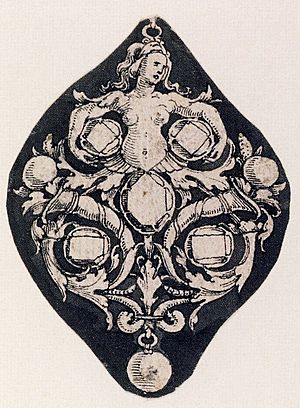Cornelis Hayes facts for kids
Cornelis Hayes (sometimes spelled Heys) was a talented jeweller from a place called Flanders (which is now part of Belgium). He moved to London, England, in 1524 and became very famous for making beautiful items for the royal family.

Contents
Working for Royalty
Cornelis Hayes was a trusted jeweller for King Henry VIII and his queens. He created many amazing pieces for them.
Jewels and Decorations
- In 1527, he made a special jewel with 19 diamonds for Anne Boleyn, possibly for Valentine's Day.
- He also made fancy gold decorations called "gilt pommels" for a bed that King Henry VIII used when he went hunting. These decorations had roses and the King's special symbols.
- Hayes sold 19 diamonds to King Henry VIII for Anne Boleyn's headpiece. He also made her a gold belt and an emerald ring.
- He even made "spangles" (which are like sequins) to decorate the uniforms of the King's guards.
- His workshop grew, and he was allowed to hire many apprentices and skilled workers.
Special Royal Items
- For Anne Boleyn's coronation as Queen in 1533, Hayes helped repair a royal sceptre.
- In 1534, he made a silver cradle, possibly for Anne Boleyn's second baby. The famous artist Hans Holbein the younger painted figures of Adam and Eve on it, and Hayes added apple shapes in 3D.
- Hayes also updated royal tableware. For example, he changed the symbols of Cardinal Wolsey on gold plates to King Henry's royal symbols.
- He also changed a pomegranate symbol (which belonged to Catherine of Aragon) on a salt shaker to a rose, representing the new Queen.
- He repaired a special gold salt dish from the royal kitchen that was very old, originally made for King Richard III. This dish had a figure of a person holding it up, and it sometimes got broken.
Pearls and Other Treasures
In 1535, a list was made of the jewels Hayes had given to King Henry VIII. This list included 60 large pearls and 440 smaller ones. It also mentioned a "toadstone," which people at the time believed could protect against poison.
Working for Queens
Cornelis Hayes also supplied silver plates for the people who came with Anne of Cleves when she arrived in England to marry King Henry VIII. He was even made her official goldsmith. Later, in 1544, he also supplied silver items to Princess Mary (who would later become Queen Mary I).
Designs by Hans Holbein
It is thought that Cornelis Hayes might have created some of his beautiful jewellery and other items based on drawings made by the famous artist Hans Holbein the Younger. This shows how skilled Hayes was, as he could turn Holbein's artistic ideas into real, sparkling objects.
His Life and Legacy
Cornelis Hayes lived in London in a parish called All-Hallows-the-Great. He had several workmen helping him, including Lambert Wolf and John Pynne. He was married to Anne, who was a widow. In his will, he left his properties outside England to his friends, the glazier Galyon Hone and the goldsmith Paul Fryling.
Kremlin Water Pots
Some of Cornelis Hayes's amazing work ended up in a very famous place: the Kremlin Armoury Museum in Moscow, Russia.
A Royal Gift
In 1604, King James VI and I of England gave two large water pots made by Hayes to a Spanish nobleman named Juan Fernández de Velasco. Drawings were made of these beautiful pots.
Russian Replicas
Later, in 1629, the Russian Tsar, Michael of Russia, bought some similar water pots from an English merchant. These pots, made by another goldsmith named William Jefferies, might have been copies of Hayes's original designs. Today, these impressive pots are kept in the Kremlin Armoury Museum.
Unique Features
The Kremlin pots have special features like dragon-shaped spouts and snake-shaped handles. Other pots listed in Queen Elizabeth I's inventory also had these unique designs, showing how popular and admired Hayes's style was.

